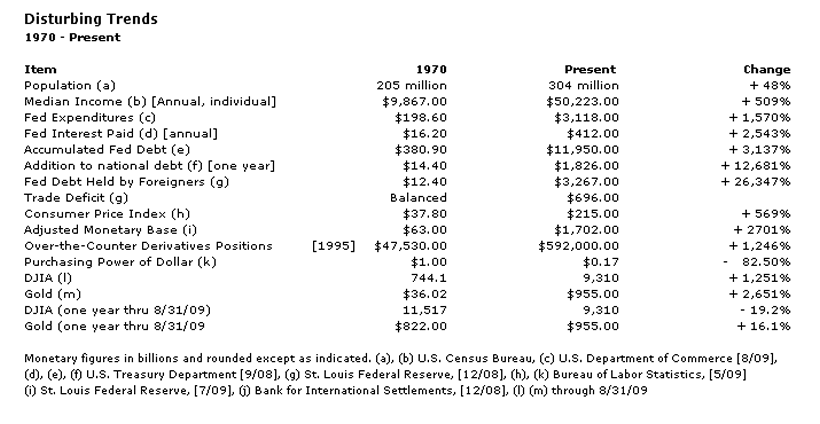Disturbing Financial and Economic Trends 2009
Economics / Credit Crisis 2009 Sep 15, 2009 - 09:32 PM GMT Bail, rescue, print formula
no cure for what ails America.
Bail, rescue, print formula
no cure for what ails America.
"[E]normous dosages of monetary medicine continue to be administered and, before long, we will need to deal with their side effects. For now, most of those effects are invisible and could indeed remain latent for a long time. Still, their threat may be as ominous as that posed by the financial crisis itself." -- Warren Buffett
Some might believe that we have reached a culmination of sorts for the financial crisis that began in 2008 and that from here things are going to get better. This study draws the opposite conclusion. The bail, rescue and print formula being employed by the federal government and central bank today is simply a continuation of policies that brought about the crisis in the first place. Only now, as you are about to read, they are being conducted on a far grander scale. The repercussions, I might add, are likely to arrive on a far grander scale as well.
From time to time I update this Disturbing Trends table which first appeared in my book, The ABCs of Gold Investing: How to Protect and Build Your Wealth with Gold (1997). The table's purpose is to isolate and monitor key economic data that have had an impact on gold demand in the past, and likely to affect it (and investor psychology) in the future. I use 1970 as a start date because that was the year just before the United States officially detached the dollar from gold and launched the new era of fiat currencies -- the era in which we still find ourselves today. From 1971 on, the monetary system behaved differently than it had under the gold standard. Simultaneously, individual investors began to include gold in their portfolio planning as a defense against the profligate policies that they feared would follow. As such, 1971 serves as something of a demarcation point for students of the contemporary gold market.
The numbers in the table below speak for themselves and do not require a great deal of embellishment. They describe a monetary and financial system in crisis. I last researched and prepared this table in 2007. Much has changed over the past two years, and I could not help but note that the numbers had begun to take on a distinctly Weimar-like* feel.
- Foreign-held debt up 26,347%.
- One-year addition to the national debt up 12,681%.
- Adjusted monetary base up 2701%.
- A $12 trillion national debt.
- $592 trillion in derivatives positions.
- A nearly $700 billion trade deficit.
- And, last but not least, a currency that has depreciated by 82%.
At the end of each one of those examples I could have added ". . .and counting." This is not the kind of report card that generates a great deal of faith, or even sympathy, but rather some nagging questions about how it all happened.
Disturbing Trends is simultaneously one of the least and most popular pieces I have written. Whenever it is updated, I get numerous requests for reprint. I also get complaints about its bleak view of the future. As the saying goes though, the turtle never got anywhere by keeping his head in his shell. Likewise, today's saver/investor stands a greater chance of staying out of harm's way by understanding the problem rather than ignoring it. So bleak though this study may be, it also serves a positive purpose as an unambiguous call to action.
Please keep in mind that the first wave of investors who reacted to the message in Disturbing Trends paid between $250 and $300 per ounce for their gold. These early buyers have emerged from the latest round in the on-going financial crisis with their wealth relatively intact (assuming they achieved the recommended 10% to 30% diversification). Also, be aware that none of the conditions that induced those initial purchases has changed, except that they have decidedly worsened.

*The Nightmare German Inflation (Weimar Republic, 1922-1923) "The many parallels between 1924 Germany and present-day United States are cause for concern. Though the U.S. has not yet reached the depths to which Germany descended in that era, few can look at the constant depreciation of the dollar since the early 1970's and fail to be alarmed. It seems contemporary America differs from 1924 Germany only in the duration between cause and effect. While the German experience was compressed over a few short years, the effects of the American inflation have been more drawn out."
By Michael J. Kosares
Michael J. Kosares , founder and president
USAGOLD - Centennial Precious Metals, Denver
Michael Kosares has over 30 years experience in the gold business, and is the author of The ABCs of Gold Investing: How to Protect and Build Your Wealth with Gold, and numerous magazine and internet articles and essays. He is frequently interviewed in the financial press and is well-known for his on-going commentary on the gold market and its economic, political and financial underpinnings.
Disclaimer: Opinions expressed in commentary e do not constitute an offer to buy or sell, or the solicitation of an offer to buy or sell any precious metals product, nor should they be viewed in any way as investment advice or advice to buy, sell or hold. Centennial Precious Metals, Inc. recommends the purchase of physical precious metals for asset preservation purposes, not speculation. Utilization of these opinions for speculative purposes is neither suggested nor advised. Commentary is strictly for educational purposes, and as such USAGOLD - Centennial Precious Metals does not warrant or guarantee the accuracy, timeliness or completeness of the information found here.
Michael J. Kosares Archive |
© 2005-2022 http://www.MarketOracle.co.uk - The Market Oracle is a FREE Daily Financial Markets Analysis & Forecasting online publication.



